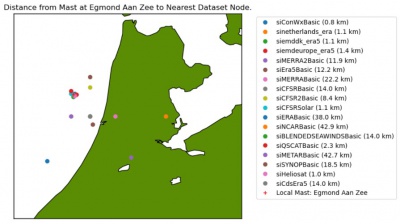EMD-API: EMD-WRF On-Demand
Introduction

The EMD-API: EMD-WRF On-Demand is a part of EMD-API. It provides a unified interface to the EMD-WRF mesoscale on-demand services - aimed at detailed time-series analysis. EMD-API helps consultants, analysts and scientists working with high-resolution climate data in achieving their goals in an efficient way. It has the following key-features:
- Global data delivery - and calculated on-demand: All models in the EMD-API - EMD-WRF On-Demand has a global footprint - so you can make your calculations virtually everywhere.
- On-demand calculation: - Calculations are executed on-demand at the High-Performance computing (HPC) facilities at EMD
- Multiple model configurations: EMD-API - EMD-WRF On-Demand provides access more multiple model configurations aimed at single points or larger areas - and even a special configuration aimed at icing calculations.
- Unified interface: The unified interface which allows for integration to internal processes and tools - and also very efficient uncertainty analysis with gigabytes of data easily accessed.
- Trusted datasets: EMDAPI builds upon the trusted data-bases and data-sources that have been used through the online-data services in windPRO for more than a decade.
- Built on open standards: EMDAPI is a REST based service that implements the OpenAPI standard].
- Available from any development tool: Access to the climate databases is available from your preferred development platform - C#, R, python, html, java, php, scala and swift. Just use the OpenAPI tools to generate the client software for your preferred platform.
Access
To see more documentation and to access the data-services, please visit the API through the following URL's:
- EMD-API Overview (Wiki) - here.
- EMD-API Main Page (API) - here.
- EMD-API Climate Data UI (API) - here.
Any technical questions on our climate databases can be addressed to our Senior Technical Specialist - Morten Lybech Thøgersen: mlt@emd.dk.
Data Model - EMD-API: EMD-WRF On-Demand
The EMD-API: EMD-WRF On-Demand -services is documented in a REST based API using the OpenAPI Specification. You can view the interfaces and download the interfaces as json or yaml, here. The service provides the following functionality:
- List Models: Full list of available models including their ID’s and other meta-data
- Information on used and purchased credits: Request information of completed, cancelled or pending calculations for your company account.
- Place Order: Order a mesoscale time-series data for any location whith any model (dataset) - given any latitude-longitude location). You can decide which period to download.
- Order Status: Request progress for an order - and eventually recieve the download URL for the order. Options: [PENDING, CANCELLED OR SUCCESS].,
- Cancel Order: Cancel an order that has not started yet (status must be PENDING)
Python - Installation

The simplest way to use the EMDAPI with python is to install the client software in a virtual environment. If you are using CONDA or MINICONDA, we recommend that you create a new virtual environment and use a recent 3.x version of python. When the virtual environment is created, then activate the environment.
Open your Anaconda Prompt. Copy-paste the following lines:
conda create -n emdapiclient python=3.8.5 conda activate emdapiclient
Install the required packages needed in order to do data-science and use the examples provided within the jupyter notebooks. We have have validated this setup using specific package versions (used in the commands below).
In the Anaconda Prompt, copy-paste the following lines, one by one:
conda install -c conda-forge pandas=1.1.0 numpy=1.19.1 conda install -c conda-forge matplotlib=3.3.1 basemap=1.2.2 basemap-data-hires=1.2.2 conda install -c conda-forge jupyter=1.0.0 ipykernel=5.3.4 conda install -c conda-forge python-wget
Download the zipped-file holding the OpenAPI python client.
Unpack the file and install it within your virtual environment:
In the Anaconda Prompt: Move to the folder, where you have unpacked the zipped file. Copy-paste the following line:
python setup.py install
Make sure that the new emdapi virtual enviroment (python-kernel) is available to be used with jupyter-notebook environment:
python -m ipykernel install --user --name=emdapiclient
Python - Jupyter Notebooks for Demonstration and Test
In order to test your setup and learn to use the EMDAPI, we suggest that you download the jupyter-notebook examples that we have created - here.
Unpack the zip files and run the command below in your terminal or command-shell.
If jupyter prompts for you to select another python-kernel, then select the emdapiclient kernel (may also be selected directly from the 'Kernel' drop-down menu).
In the Anaconda Prompt: Move to the folder, where you have saved the jupyter-notebook examples. Copy paste the following line to open jupyter notebook from where you can open the examples.
jupyter notebook
Within the internet-browser (and jupyter user-interface), run select the notebook file (*.ipynb).
Then work your way through through each example provided. Each jupyter notebook holds a separate topic:
- emdapi_availability.ipynb Demonstration of login to the system, then check which datasets are available at a specific location.
- emdapi_correlation.ipynb: Correlation analysis (R2), check which climate datasets correlates the best against the Egmond Aan Zee data
- emdapi_random.ipynb: Download climate data from any part of the world.
Client Software Other Languages and Tools
REST and OpenAPI is easily consumed from a lot of software tools. It is perfectly possible that your preferred language is supported. OpenAPI works well with languages such as - but not limited to - C#, R, python, java, php, scala and swift. Just download the YAML or JSON service description and use the Swagger Editor or OpenAPI Generator to generate the client libraries for your preferred software. Then you are ready to integrate towards your preferred systems and workflows.
To generate the client libries yourself - one possible process is to: